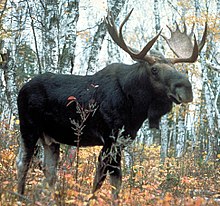Algonquin to Adirondacks Collaborative
| Formation | 2002 |
|---|---|
| Headquarters | |
Membership | 150 |
President | Sarah Walsh |
| Website | www |







The Algonquin to Adirondacks Collaborative (A2A)
History
In the 1990s, the Ottawa Valley chapter of the Canadian Parks and Wilderness Society[4] convened a committee to discuss a landscape conservation effort to ensure ecological connectivity and help restore biodiversity from Algonquin Park to the Adirondacks, along the Frontenac Arch.[5] The Algonquin to Adirondacks (A2A) Conservation Association (now Collaborative) was incorporated in 2002 to enhance habitat connectivity and maintain native biodiversity in the region. The organization is similar to its sister conservation corridor in western North America, the Yellowstone to Yukon Conservation Initiative, and Two Countries, One Forest (a project of the Wildlife Conservation Society), in conducting landscape conservation work across international boundaries.
In the first decade (2002-2012) the A2A Conservation Association worked to support partner organizations, and conduct projects with their help, on the Canadian side of the Thousand Islands region of the St. Lawrence River. This area was strategic because it is the pinch point of the A2A Region and the communities on the Canadian side were very engaged in conservation efforts. Projects included water quality analyses, shoreline analyses, and creating resources for landowners.
During two visioning workshops in 2012, partners identified the need for the A2A Conservation Association to be reimagined as a Collaborative. This led to a change in name and organizational structure. In response to the notable lack of American representation, partners also called for the A2A Collaborative to better embody its name by becoming a less local and more regional initiative with more American representation. Concerted outreach led to new American partners and American members of the Board of Directors. In 2014, the A2A Collaborative received capacity-building support from the Ontario Trillium Foundation to hire a full-time coordinator and hold partner events. The inaugural A2A Collaborative Partner Meeting in Brockville, Ontario, March 29–30, 2014, saw 42 participants representing 31 different organizations across the A2A Region.
Biodiversity
Mammals: In the A2A Region there are an estimated 54 species, including
Birds: More than 165 confirmed species of breeding birds in the region — eight vulnerable species and two endangered. As a result, 60% of the area falls into the highest possible class for number of species (>104 species/100 km2).[6]
Reptiles: 17 species, five of which are uncommon.[6]
Plants: 81 rare species, including
Vision
The A2A Collaborative's vision is of "an A2A region comprising a resilient, ecologically interconnected landscape that sustains a full range of native wildlife and enhances people's quality of life for generations to come."[7]
Recognition
In 2004, the A2A Collaborative was recognized by the North American Native Plant Society, with the Paul McGaw Memorial Conservation Award, for its efforts to maintain and restore the natural connectivity for flora and fauna.
In 2010, the A2A Collaborative was recognized by Ontario Nature, with the Steve Hounsell Greenway Award, for its major contributions toward the Greenway vision.
Challenges
- Reducing habitat fragmentation
- Fostering landowner enthusiasm and commitment
- Sustaining organizational capacity
- Shifting from a local focus to a more regional perspective
- Making concrete progress toward the vision
Projects
Connectivity Analysis: In partnership with the
Highway 401 Wildlife Crossings: In partnership with the Ontario Road Ecology Group, and supported by the
A2A Trail: A new project to build a hiking trail from Algonquin to Adirondacks parks with the goals of fostering an identity for the region, recreational possibilities, increased human well-being, and local economic activity.
See also
- Canadian Parks and Wilderness Society
- Landscape scale conservation
- National Parks of Canada
- Yellowstone to Yukon Conservation Initiative
References
- ^ "Algonquin to Adirondacks Collaborative website". Retrieved May 8, 2014.
- ^ Map of the A2A Region, drawn by Ken Buchan, 2014. http://www.a2acollaborative.org/uploads/7/6/8/5/7685208/1904164_orig.jpg?330
- ^ Keddy, Cathy (November 1995). "The conservation potential of the Frontenac Axis: Linking Algonquin Park to Adirondacks" (PDF). The Canadian Parks and Wilderness Society - Ottawa Valley Chapter: 72. Retrieved May 8, 2014.
- ^ "Canadian Parks and Wilderness Society, Ottawa Valley chapter". Retrieved May 20, 2014.
- ^ "CPAWS, Ottawa Valley, Algonquin to Adirondacks campaign". Retrieved May 20, 2014.
- ^ a b c d "Appendix 4: Case for support, (p. 57), Algonquin to Adirondacks Conservation Association Workshop #2 Proceedings (October 2012)" (PDF). Retrieved May 20, 2014.
- ^ "Algonquin to Adirondacks Collaborative Vision". Retrieved May 5, 2014.
